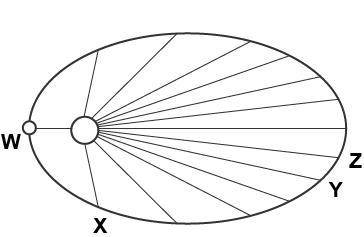
Physics, 13.11.2020 05:30 acesangel173
The image shown is an illustration of Kepler’s second law.
Which conclusion is best supported by the image?
A) The gravitational force at W is less than the gravitational force at Y.
B) The time needed to travel from W to X is the same as the time needed to travel from Y to Z.
C) The gravitational force at W is the same as the gravitational force at Y.
D) The time needed to travel from W to X is greater than the time needed to travel from Y to Z.
ANSWER: B) The time needed to travel from W to X is the same as the time needed to travel from Y to Z.


Answers: 3


Another question on Physics

Physics, 22.06.2019 10:50
Asheet of steel 1.5 mm thick has nitrogen atmospheres on both sides at 1200oc and is permitted to achieve a steady-state diffusion condition. the diffusion coefficient for nitrogen in steel at this temperature is 6 x 10- 11 m2 /s, and the diffusion flux is found to be 1.2 x 10-7 kg/m2 -s. also, it is known that the concentration of nitrogen in the steel at the high-pressure surface is 4 kg/m3 . how far into the sheet from this high-pressure side will the concentration be 2.0 kg/m3 ? assume a linear concentration profile.
Answers: 3

Physics, 22.06.2019 11:30
Water is siphoned from a large tank and discharges into the atmosphere through a 50-mm diameter tube. the end of the tube is b = 2.1 m below the tank bottom which is a = 7.4 m deep, and viscous effects are negligible. determine the maximum height h over which the water can be siphoned without cavitation occurring. atmospheric pressure is 101.4 kpa, and the water vapor pressure is 1.79 kpa (absolute)
Answers: 3

Physics, 22.06.2019 14:40
The experiment done in lab is repeated, using a ball that has unknown mass m. you plot your data in the form of f 2 versus m/l, with f in rev/s, m in kg, and l in m. your data falls close to a straight line that has slope 3.19 m/(kg · s2). use g = 9.80 m/s2 and calculate the mass m of the ball.
Answers: 1

Physics, 22.06.2019 16:30
Acalorimeter uses the principle that thermal energy flows from hotter material to colder material until both reach the same
Answers: 1
You know the right answer?
The image shown is an illustration of Kepler’s second law.
Which conclusion is best supported by th...
Questions

Social Studies, 12.12.2019 17:31

English, 12.12.2019 17:31

Mathematics, 12.12.2019 17:31


Social Studies, 12.12.2019 17:31

English, 12.12.2019 17:31



Mathematics, 12.12.2019 17:31

Geography, 12.12.2019 17:31

Geography, 12.12.2019 17:31

Physics, 12.12.2019 17:31


Spanish, 12.12.2019 17:31

Computers and Technology, 12.12.2019 17:31

Social Studies, 12.12.2019 17:31

Social Studies, 12.12.2019 17:31

Mathematics, 12.12.2019 17:31




